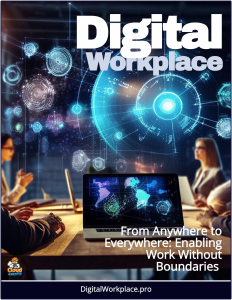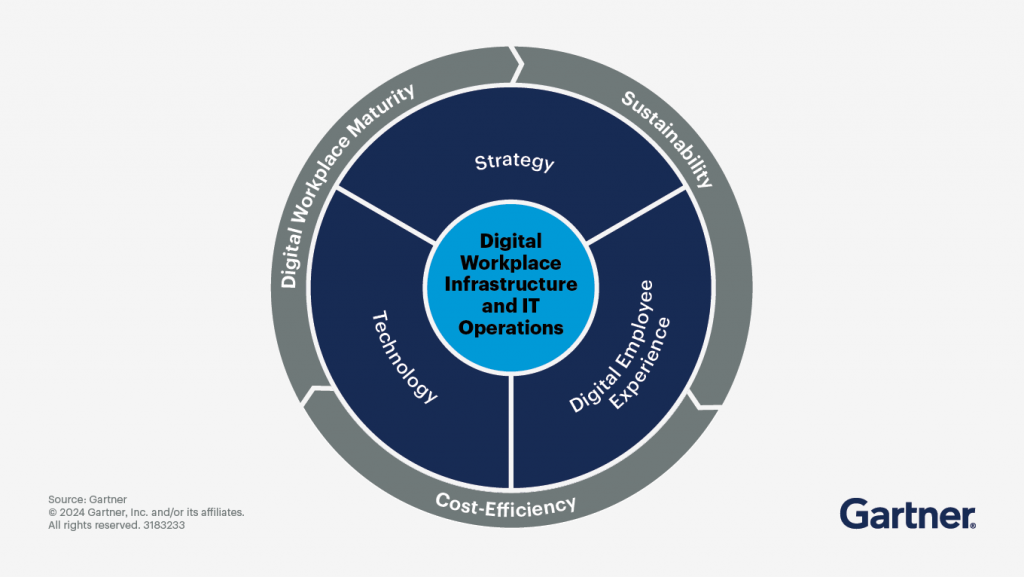The Role of IT Leadership in Digital Workplace Strategy
Gartner believes that a successful digital workplace is not just about deploying technology but about aligning it with a clear vision, a strategic roadmap, and a focus on employee experience.
 Gartner’s thinking and strategy for building the Digital Workplace revolve around creating a flexible, engaging, and technology-enabled environment that enhances employee agility, productivity, and satisfaction while aligning with broader business goals.
Gartner’s thinking and strategy for building the Digital Workplace revolve around creating a flexible, engaging, and technology-enabled environment that enhances employee agility, productivity, and satisfaction while aligning with broader business goals.
Gartner views the digital workplace as a holistic ecosystem that integrates people, processes, and technology to enable new, more effective ways of working.
It emphasizes leveraging consumer-oriented technologies and styles to boost digital dexterity—the ability and ambition of employees to use technology to drive business outcomes. Below is an overview of Gartner’s approach, based on their frameworks and insights:
Core Philosophy
Gartner believes that a successful digital workplace is not just about deploying technology but about aligning it with a clear vision, a strategic roadmap, and a focus on employee experience. It’s a strategic enabler of digital transformation, aiming to improve customer-centricity, foster employee-led innovation, accelerate processes, and enhance workforce retention.
The digital workplace is already present in every organization—it’s not something to “build from scratch”—but it often requires intentional management to move from a fragmented, siloed state to a cohesive, impactful system.

The Eight Building Blocks
Gartner outlines eight critical components, or “building blocks,” that form the foundation of a robust digital workplace strategy. These blocks provide a structured approach for planning, implementing, and evolving digital workplace programs:
- Vision: A compelling vision articulates what success looks like and how it benefits stakeholders. It should align with organizational values and inspire action, serving as the guiding star for all subsequent efforts.
- Strategy: This involves creating a roadmap to achieve the vision, defining clear goals for a digitally empowered workforce. It prioritizes initiatives that support business objectives and prepares the organization for evolving work models.
- Metrics: Measuring the value of digital workplace initiatives is key. Gartner suggests focusing on metrics like workforce effectiveness, employee agility, satisfaction, and retention to assess impact and guide continuous improvement.
- Employee Experience: Designing for seamless, intuitive interactions is central. The digital workplace should cater to employee needs, enhancing engagement through personalized tools and reducing digital friction—unnecessary effort in using technology.
- Organizational Change: Successful adoption requires cultural and behavioral shifts. Gartner advises starting small but thinking big, embedding change management to reshape processes, structures, and incentives over time.
- Processes: Re-engineering high-impact work processes is critical. This involves analyzing current workflows, introducing collaborative tools, and adapting outdated practices to make work more agile and responsive.
- Technology: Gartner advocates a platform approach, integrating tools like AI, IoT, and collaboration suites (e.g., Microsoft 365, Google Workspace) to support employees, customers, and ecosystems. Technology should be scalable and adaptable to future innovations.
- Leadership Culture: Senior leaders must model desired behaviors, engage employees, and hold peers accountable. This block emphasizes the role of leadership in driving adoption and aligning the digital workplace with strategic priorities.
Strategic Considerations
- Human-Centric Design: Gartner stresses designing around employee personas and critical user journeys, ensuring tools and processes meet real needs rather than being purely technology-driven.
- Digital Dexterity: Building employees’ skills and confidence with technology is a priority. This includes fostering roles like “data mavens” or “process hackers” who can leverage tools creatively.
- Hybrid and Remote Work: Post-2020, Gartner recognizes the shift to hybrid models, advocating for technologies that support flexibility (e.g., collaboration tools, cloud platforms) while maintaining equity in access.
- Business-IT Alignment: The digital workplace bridges IT and business units, often involving “fusion teams” that blend technical and business expertise to deliver outcomes faster.
Evolution and Trends
Gartner’s strategy evolves with emerging trends. By 2027, they predict multidisciplinary teams will outperform IT-only teams by 50% in delivering positive outcomes, driven by business-led IT and tools like generative AI. They also highlight “smart workspaces” (e.g., IoT-enabled offices) and “nudge-tech” (AI-driven prompts) as future enhancers of efficiency and engagement.
Practical Execution
Gartner advises starting with a clear purpose to catalyze commitment, then iteratively refining the strategy with feedback from metrics and employee input. They caution against fragmented, tech-only fixes, urging a holistic approach that ties the digital workplace to business strategy. For organizations already underway, the building blocks serve as a checklist to reassess and refine efforts.
In summary, Gartner’s strategy for the digital workplace is a comprehensive, employee-focused framework that balances vision, technology, and culture. It aims to transform how work gets done, making it happier, faster, and smarter while positioning organizations to thrive in a digital-first world.



